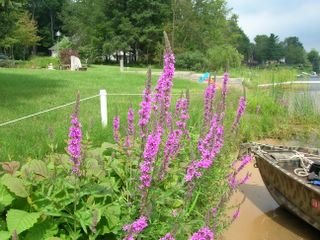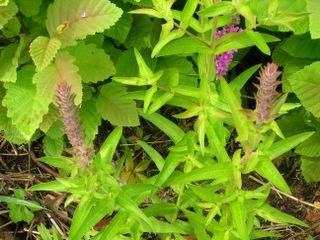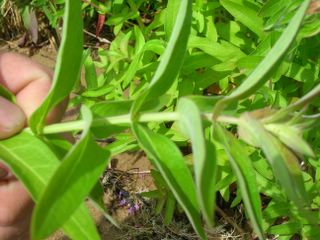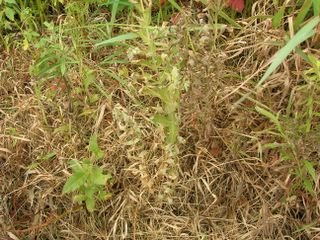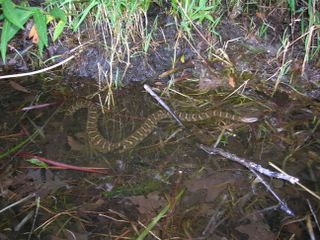
Controlling PL is not as easy as hopping in a boat and snipping and spraying a few plants. We encounter all sorts of critters along the way from snapping turtles to disgruntled muskrats to this Northern Watersnake. She was just looking for a nice juicy tad pole or injured bluegill for dinner and she ran into us. She never even moved as we waded by, but then again I have that effect on many women.
Summit Labs Canadian Lakes Management
The Summit Labs Canadian Lake Management Blog was created to provide Canadian Lake Riparian owners better access to us, their lake managers. Communication is essential in successful lake management. Efficient communication allows us to maximize our time managing while satisfying riparians questions and concerns.
Tuesday, August 22, 2006
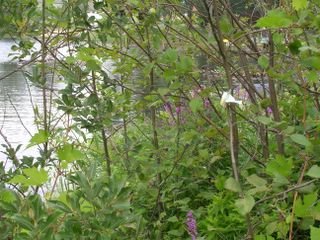
The white/yellow object hanging from this tree is a pheromone lure designed to attract Japaneese Beetles. We placed it on the larger Far West island to get the beetles to leave your roses alone and to come to the island to enjoy a PL plethera as you can see in the back ground. The island is too soft for us to walk on but the beetles should love it.
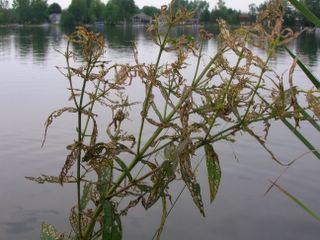
This PL plant was decimated by Japaneese beetles. You might know these pest insects as the ones that devowered your ornimental plants. In this particular stand on Far West, these beetles where able to keep the PL from flowering. Unfortuneately, these and other beetle species are not yet up to the challenge of eating all the plants across the state, or at least those in CL.
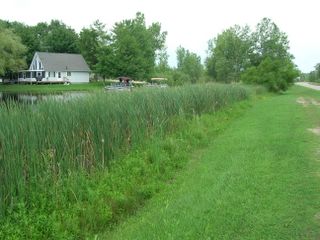
Mowing PL is a bad idea. This image shows a length band of juvenile PL plants between the grass and the cattails along Pierce Road. This band is almost completely PL. It spread and choked out other plants without ever flowering. When the lake levels were restored, the higher water kept the mowers from topping these plants. The result in 2006 was this band which we treated thoroughly with systemic herbicides.
Summit Lab’s Purple Loosestrife Control for 2006 is Complete!
As of last Saturday, August 19, Summit Laboratory’s Purple Loosestrife control efforts for 2006 are complete. This battle lasted almost a month as we did our best to closely monitor past years known growth areas as well as trying to monitor all of the CL waterbody’s shorelines. We GPS’ed and pulled/treated plants on Lake Laura, North Camper Pond and the Main Lakes chain. This is back breaking and time consuming work. Some of the areas hosting PL growth are very difficult to access. PL seeds are easily airborne and love to blow back into the most remote corners of the shore. If you happen across flowering PL at this point in the season, we ask that you might be willing to pluck and bag the flower on site. Sealed bags can be tossed in the garbage or burned. Every year there is a hand full of late flowering plants that avoid detection during our control efforts. When considering the many many miles of CL we patrol, it is impossible for us to be all places at all times and we greatly appreciate your help in this effort. Remember that one flower can produce thousands of seeds so it is critical at the very least to minimize or ideally eliminate all PL flowers.
Looking back at the three years we have been fighting this plant in CL, we have really gotten to know the enemy. The following are observations from the field:
1. Mowing, weedwipping or cutting down PL will not kill it. As long as the plants root system remains at all in tack, it will be back to flower again next year. In 2004 we pulled every plant we encountered. In 2005 we did the same but began to realize that even the slightest bit of remaining root will give rise to a flowing adult the following year. We also saw that in many of the stands, seed banks had become established in the soil because in the past years, these plants were allowed to flower and go to seed. The result was more plants in 2005 than in 2004! Remember, if you mow it, and it doesn’t flower, we will not be able to find and treat it.
2. Treating adult flowering plants with herbicide doesn’t work. Some of the currently densest patches are those that were treated in 2003 with boat delivered general herbicides. If you spray the flowering plant, you will kill it and all the other native plants around it. However, the seeds will still mature and drop into the now bare ground around the dead parent plant. The next season you have hundreds of plants where you only had one before!
3. Looking at other research and our own, the best control strategy for low density populations is a combination of hand pulling young plants and removing all flowering bud terminals from the adult plants. Once the flowers and buds have been removed we give them a nice cool drink of hand delivered systemic herbicide, which the plants take into their root systems and dye. We take great care to avoid treating the native plants around the PL as though they do not keep the PL out completely, they do slow it’s spread and ultimately these natives are the critical support vegetation we are looking to save.
4. Looking across the Mid-West, most state and Federal agencies have given up on eradication efforts. They have accepted the fact that this plant is here to stay. In time, insect predation and competition from other plants will begin to bring it into check and it will become just another member of the wetland community. But I cannot understate that we are years away from this point and in the meantime, PL will cause serious disruptions in even larger lake systems. People always think I’m nuts but PL can actually have a pronounced negative impact on a lakes fishery as loss of native vegetation results in the loss of insects which results in the loss of shoreline mammals, reptiles and amphibians which can result in the lack of food for critical life stages of some of our fish species! None of our natural resource managers have given up on PL control. They have simply adjusted to a more appropriate and feasible mode of PL control, biological control. Biological control using select species of reared beetles is fairly inexpensive and seems to be producing some results in larger dense patches. We implemented this strategy on the larger island in Far West Lake. The island is a floating organic bog, making it impossible to walk on. It is the perfect habitat for the PL and it has taken over the island. We can’t get to the plants… but maybe the beetles can. We placed pheromone tabs on the island to attract the beetles to the PL buffet.
In summary, we will continue to battle low-density stands of PL along the CL shoreline where we can. Ultimately, the PL will most likely win but not before the rest of the biological community begins to catch up with it and bring it into check. We are using the most effective technique out there while experimenting with biological control in high-density low risk areas like the island in Far West. CL residents need to understand that PL has been in CL for many years and got a major jump on us prior to 2004. It is much more widespread than most people realize as our control efforts make it appear to be completely under control. The enemy is at the gate but we are not going out with out a passionate scientifically driven fight.
